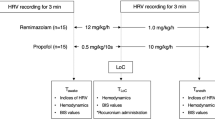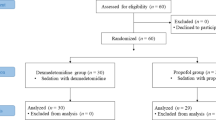Abstract
We evaluated cardiac vagal activity during sevoflurane anesthesia in neurosurgical patients. Heart rate variability was determined by power spectral analysis and entropy with the patient awake and during sevoflurane anesthesia. High frequency power (0.15–0.50 Hz) and heart rate entropy decreased during sevoflurane and these effects were significantly correlated (r = 0.71 ± 0.12, P < 0.05). The results confirm that cardiac vagal activity was the primary determinant of heart rate variability, which was attenuated by sevoflurane.


Similar content being viewed by others
References
(1996) Task force of the European Society of Cardiology and the North American Society of Pacing and Electrophysiology. Heart rate variability: standards of measurement, phsiological interpretation, and clinical use. Circulation 93:1043–1065
Amano M, Oida E, Moritani T (2005) Age-associated alteration of sympatho-vagal balance in a female population assessed through the tone-entropy analysis. Eur J Appl Physiol 94:602–610
Feld J, Hoffman WE, Paisansathan C, Park H, Ananda RC (2007) Autonomic activity during dexmedetomidine or fentanyl infusion with desflurane anesthesia. J Clin Anesth 19:30–36
Godet G, Watremez C, El Kettani C, Soriano C, Coriat P (2001) A comparison of sevoflurane, target-controlled infusion propofol, and propofol/isoflurane anesthesia in patients undergoing carotid surgery: a quality of anesthesia and recovery profile. Anesth Analg 93:560–565
Kanaya N, Hirata N, Kurosawa S, Nakayama M, Namiki A (2003) Differential effects of propofol and sevoflurane on heart rate variability. Anesthesiology 98:34–40
McDonald T, Hoffman WE, Berkowitz R (2001) Combining median electroencephalography frequency and sympathetic activity in an index to evaluate opioid detoxification in patients. J Neurosurg Anesthesiol 13:74–78
Naruo H, Onizuka S, Prince D, Takasaki M, Syed NI (2005) Sevoflurane blocks cholinergic synaptic transmission postsynaptically but does not affect short-term potentiation. Anesthesiology 102:920–928
Oida E, Kannagi T, Moritani T, Yamori Y (1999) Diabetic alteration of cardiac vago-sympathetic modulation assessed with tone-entropy analysis. Acta Physiol Scand 165:129–134
Oida E, Moritani T, Yamori Y (1997) Tone-entropy analysis on cardiac recovery after dynamic exercise. J Appl Physiol 82:1794–1801
Piccirillo G, Bucca C, Tarantini S, Santagada E, Viola E, Durante M, Raganato P, Mariano A, Cacciafesta M, Marigliano V (1999) Left ventricular mass and heart rate variability in middle-aged and elderly salt-sensitive hypertensive subjects. Arch Gerontol Geriatr 28:159–177
Picker O, Scheeren TW, Arndt JO (2001) Inhalation anaesthetics increase heart rate by decreasing cardiac vagal activity in dogs. Br J Anaesth 87:748–754
Porta A, Faes L, Mase M, D’Addio G, Pinna GD, Maestri R, Montano N, Furlan R, Guzzetti S, Nollo G, Malliani A (2007) An integrated approach based on uniform quantization for the evaluation of complexity of short-term heart period variability: application to 24 h Holter recordings in healthy and heart failure humans. Chaos 17:015117
Porta A, Guzzetti S, Furlan R, Gnecchi-Ruscone T, Montano N, Malliani A (2007) Complexity and nonlinearity in short-term heart period variability: comparison of methods based on local nonlinear prediction. IEEE Trans Biomed Eng 54:94–106
Porta A, Guzzetti S, Montano N, Pagani M, Somers V, Malliani A, Baselli G, Cerutti S (2000) Information domain analysis of cardiovascular variability signals: evaluation of regularity, synchronisation and co-ordination. Med Biol Eng Comput 38:180–188
Sato J, Saito S, Takahashi T, Saruki N, Tozawa R, Goto F (2001) Sevoflurane and nitrous oxide anaesthesia suppresses heart rate variabilities during deliberate hypotension. Eur J Anaesthesiol 18:805–810
Scher AM, Young AC (1970) Reflex control of heart rate in the unanesthetized dog. Am J Physiol 218:780–789
Shannon CE, Weaver W (eds) (1949) The mathematical theory of communication. University of Chicago Press, Chicago, IL
Tzeng YC, Galletly DC, Larsen PD (2005) Paradoxical respiratory sinus arrhythmia in the anesthetized rat. Auton Neurosci 118:25–31
Acknowledgement
This research was funded by the University of Illinois Department of Anesthesiology.
Author information
Authors and Affiliations
Corresponding author
Rights and permissions
About this article
Cite this article
Paisansathan, C., Lee, M., Hoffman, W.E. et al. Sevoflurane anesthesia decreases cardiac vagal activity and heart rate variability. Clin Auton Res 17, 370–374 (2007). https://doi.org/10.1007/s10286-007-0437-9
Received:
Accepted:
Published:
Issue Date:
DOI: https://doi.org/10.1007/s10286-007-0437-9




